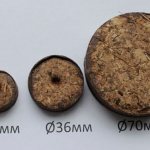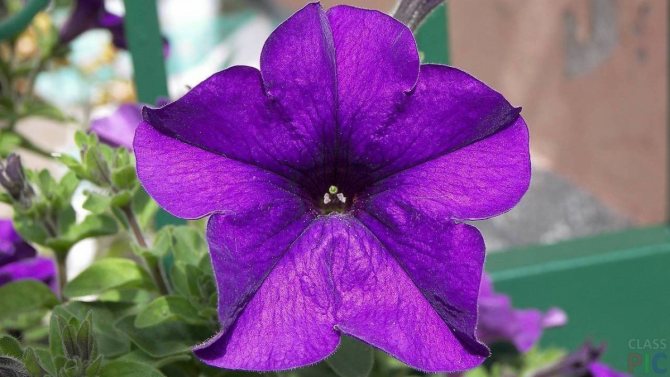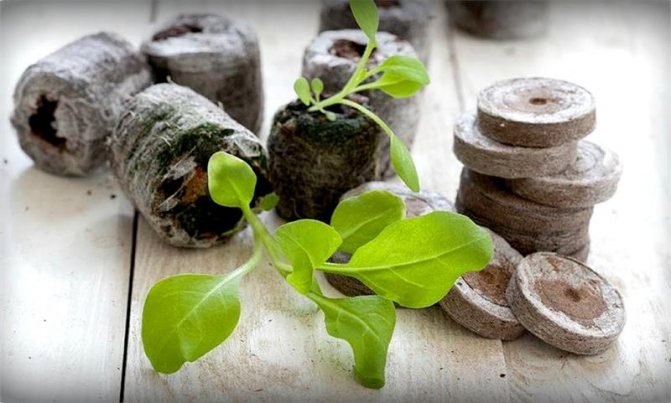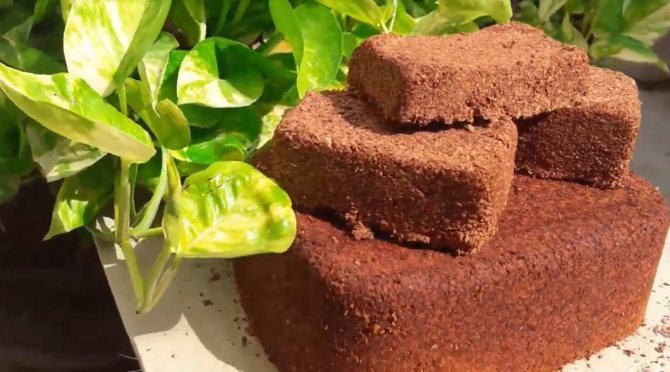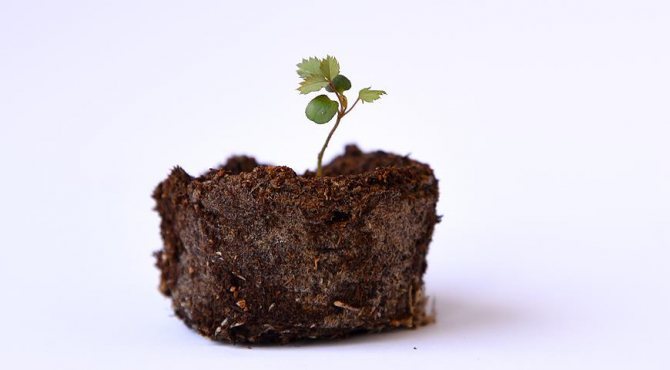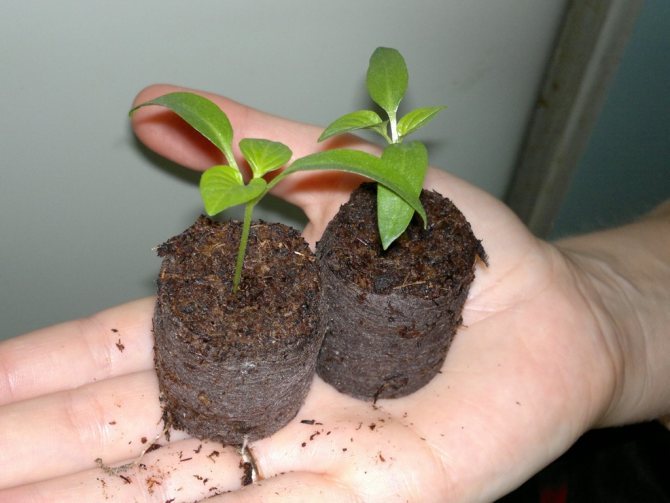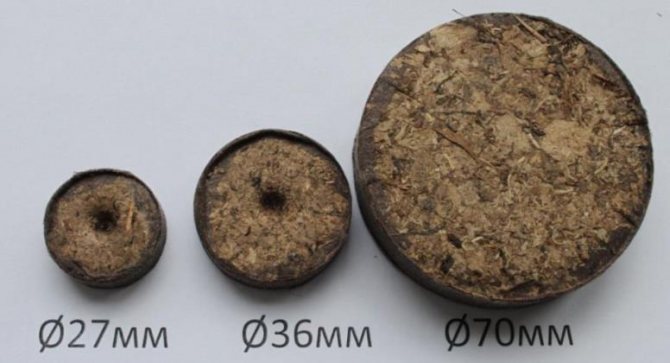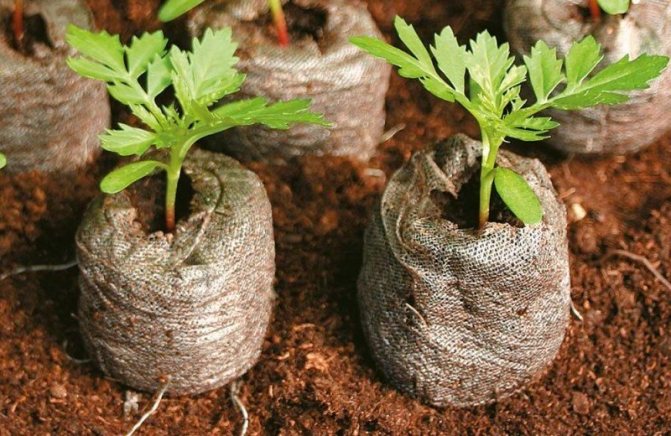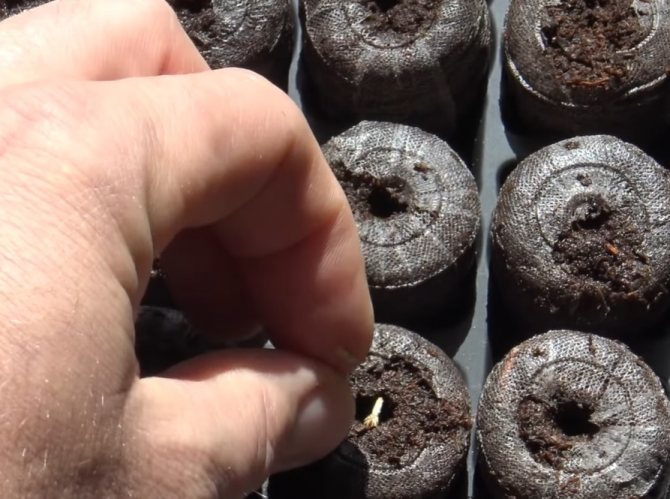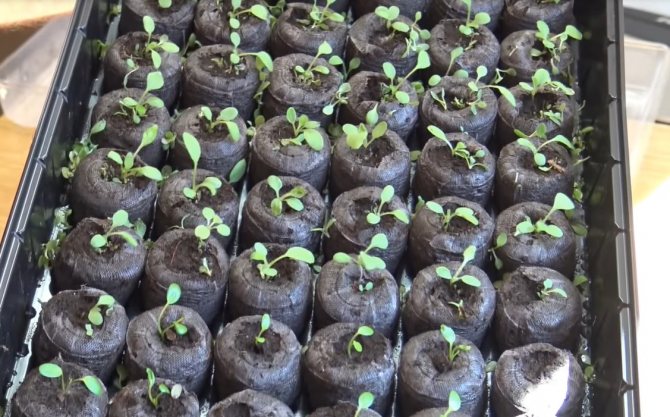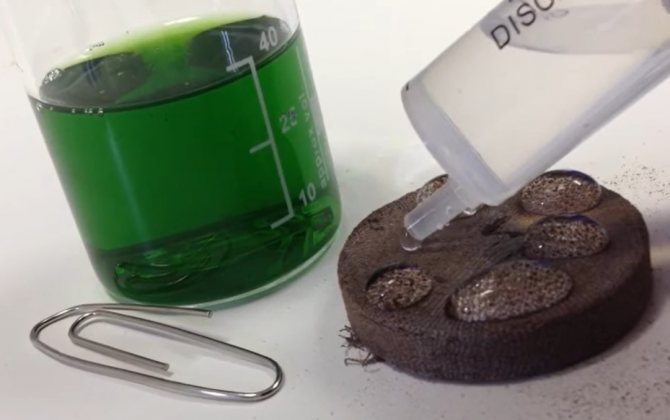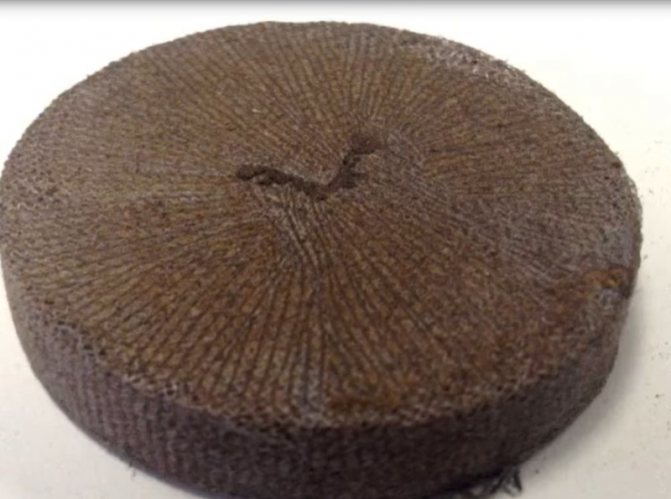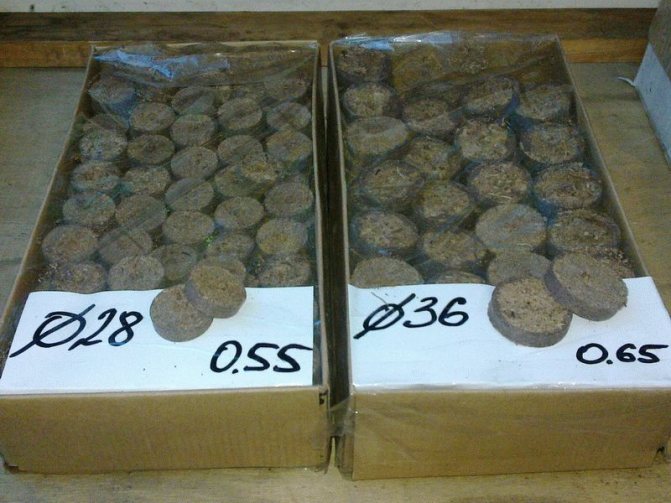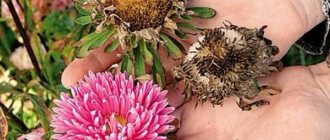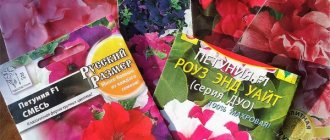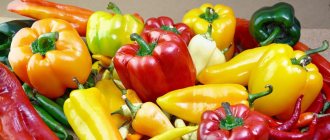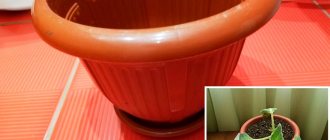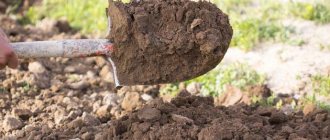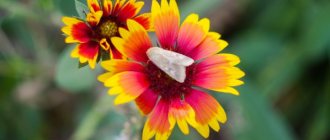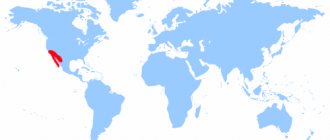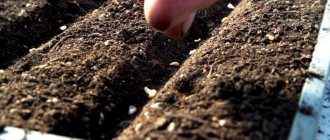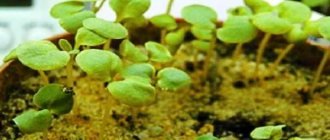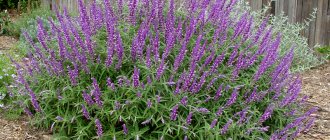Peat seedling tablets - how to use
What are peat tablets?
Peat tablets - pressed cylinders from dry high-moor peat, made with the addition of an antibacterial component, a growth stimulator and mineral fertilizers. They resemble a pill in shape, which is where they got their name.
The composition is selected so as to best promote seed germination and distillation of seedlings: peat-distillation mixture provides nutrition, antibacterial additives prevent the development of mold and fungi, mineral substances stimulate growth. Outside, the tablet is placed in a fine-mesh mesh that does not allow the soil to crumble.
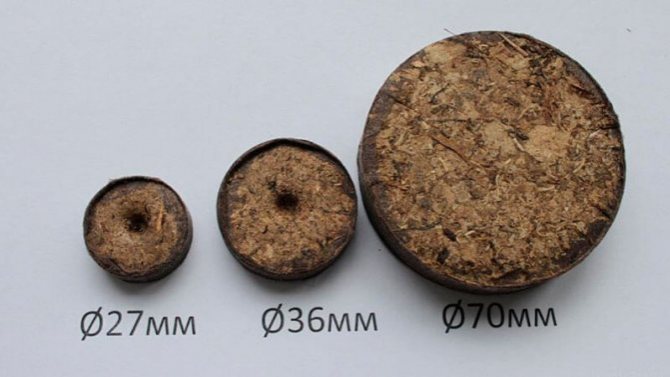
LUNAR CALENDAR - Are you under control of the landing dates?
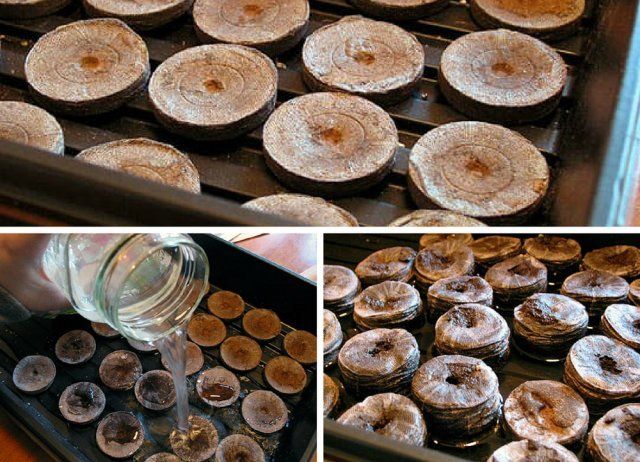

We are in social networks: Feel free to add to groups, write comments, read and discuss daily articles on social networks!


Benefits of peat tablets
Those who have already tried growing seedlings in peat tablets have appreciated the advantages of this method over traditional growing seedlings in boxes or pots. In addition to the obvious saving of space (after all, placing pallets or greenhouses with tablets takes up less space than ordinary boxes with earth), tablets have several more indisputable advantages:
- suitable for germinating seeds of delicate, capricious plants, as they do not injure the root system;
- convenient for sowing small or expensive seeds (the percentage of germination in peat tablets is very high, there is less likelihood of damage by a black leg, there is no need to thin out the seedlings);
- easily adjust the humidity level by adding water to the tray or container with tablets;
- there is no need for additional fertilizing with fertilizers and growth stimulants, since these additives are already contained in the tablets;
- peat has a "breathing" structure, which gives the roots a flow of air and makes them stronger, and the plants - hardy;
- a special mesh holds the tablet's shape, allows it to be moved without fear, and also retains its shape and allows plants to be planted directly into the soil without harming the roots;
- suitable for forcing seedlings of those plants that do not tolerate transplanting and picking.
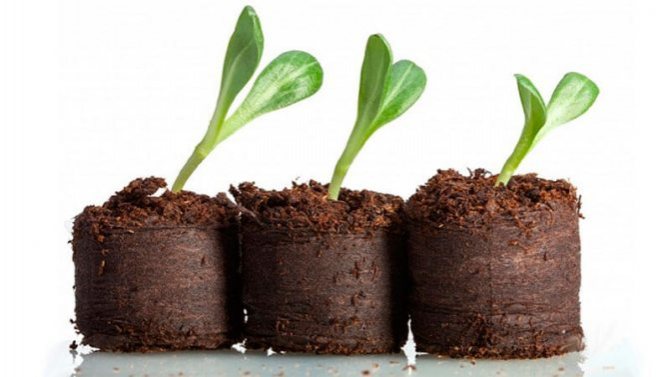

Analogs of tablets
For growing seedlings, there are, in addition to coconut and peat tablets, other tricks that make life easier for gardeners.
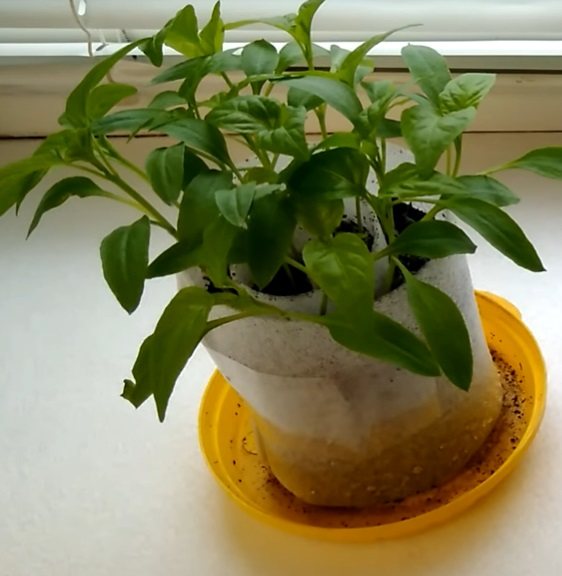

Sprouts in a glass.
Peat cups
Planting seedlings in cups has a similar order, as well as planting in the usual plastic ones. They have the same shape, they are simply made from compressed peat, humus, wood pulp. The packaging itself is a source of nutrients for the developing plant. Growing sprouts in them is much easier and faster.
Peat cups have a number of advantages:
- porous walls pass oxygen and moisture well, which are necessary for the roots;
- peat retains water well in its structure;
- natural composition that does not pollute the environment and does not affect seedlings;
- the roots can grow freely through the walls of the glass and when transplanted into the ground, the plant does not experience stress, since it is in its usual substrate;
When the cup completely disintegrates in the ground, it will become fertilizer for the further growth of the seedling. It is especially recommended to use them for the germination of delicate and demanding crops, with a weak root system - cucumbers, pumpkin, for example.
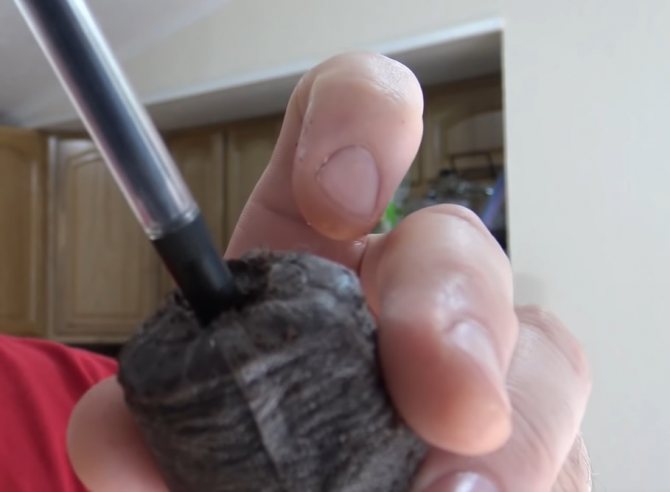

Planting the seed in a peat cup.
Peat and coconut briquettes
Special peat and coconut briquettes are made for growing seedlings. Outwardly, they resemble the shape of a brick, and are about the same size. Coconut seedling briquette is a highly compressed coconut substrate made from shredded coconut fibers, the peel of this nut. These briquettes are also used to germinate seedlings from flower seeds, vegetables and other garden plants. This material is completely safe, environmentally friendly and effective. They are produced in the form of bags, briquettes, mats of various sizes. Briquette is a compact and solid package of coconut fiber.
Related material: How to properly prepare seeds for sowing
About cassette growing of seedlings
The cluster cultivation of seedlings began to be used with an increase in the mechanization of agriculture, and a reduction in manual labor in greenhouses. As practice shows, the growth of seedlings with this method of germination is much higher and faster than that of traditional methods.
Cassette growing of seedlings has its advantages:
- Typically, this method is used in large farms that grow vegetables or flowers on an industrial scale.
- Plants with this method give the first roots faster, they are stronger and more durable.
- This method shortens the time to harvest.
One of the most important advantages of cassette cultivation is almost 100% seed germination. On sale you can find cassettes for a different number of plants and different designs.
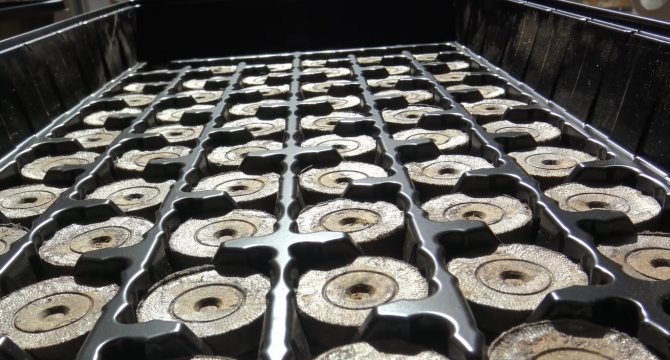

Seedling container made of peat tablets.
How to plant seedlings in a diaper
Of course, we are not talking about baby diapers, although there is a principle of wrapping the seedling. Planting seedlings in a diaper is planting a seedling in a transparent plastic bag approximately 20 * 30 cm in size. This is a good way to save space on your windowsill. So the useful space is not cluttered with cups, pots. The advantages of the method are:
- saving space;
- free and easy dive of the plant;
- less amount of nutritional formula;
- the best protection of seedlings from external factors.
This can be a backup method for growing seedlings if, for some reason, there are problems with the main method.
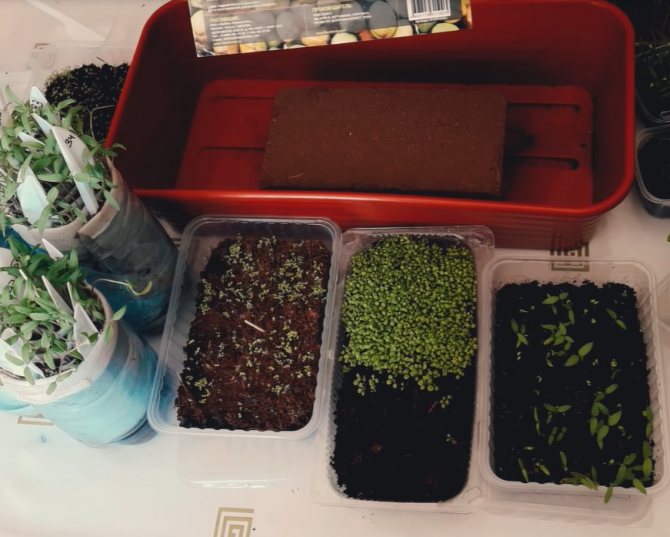

Seedlings.
How to plant seeds in a roll
Rolling seeds is a way to germinate seeds using toilet paper. It requires a roll of paper and a bag. It is better to use paper without added dyes. It is necessary to prepare strips of film 10 cm wide and 40-50 cm long, depending on the number of seeds. Then moisten the paper with water and spread the seeds on it, keeping a gap of 4-5 cm between them. This is easy to do with tweezers. After that, the paper is covered with a film and wound into a roll, while the film has shifted slightly.
How to grow seedlings in a snail
Planting seedlings in a snail is distinguished by the maximum use of useful free space. Each snail can contain 10-20 shoots. This method is especially useful for city apartments, where you need to germinate seedlings for summer cottages. You can make such a snail yourself by simply buying a laminate substrate, no more than 2mm thick. In such devices, vegetables and ornamental crops peck well.
You can also make a snail out of paper.Seedlings in a snail from a newspaper are planted in this way:
- put plastic wrap in one layer on a sheet of newspaper;
- pour the earth;
- twist into a roll.
This method is the most budgetary and does not require any costs, except for the purchase of seeds. The materials for making a snail can be very different - paper, newspaper, substrate, and others.
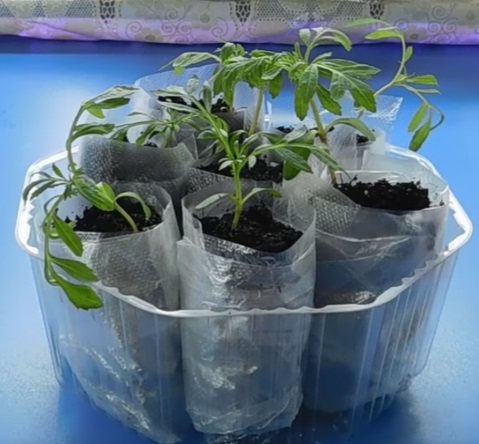

Germination of seedling seeds in a snail.
Sowing seeds in a snail without land
There is also a way to grow seedlings without soil. It is simple and clean, since there is no need to tinker in the ground. For this method you will need:
- paper;
- scissors;
- seeds;
- snail container.
The procedure should be as follows:
- Measure the width of the paper (you can use a roll of toilet paper) and cut the laminate backing a few centimeters wider along its entire length.
- Place the liner over the paper and dampen it to set the seeds.
- Place the seeds at least one centimeter apart, but one centimeter from the top edge.
- Roll the snail into a roll and fasten it with paper clips or rubber bands.
- Put the resulting snail in a container, where it should stand until germination.
At the bottom of the container there should be water, which penetrating through the paper will get to the seeds. It is necessary to monitor the degree of moisture of the seedlings, periodically adding fresh water.
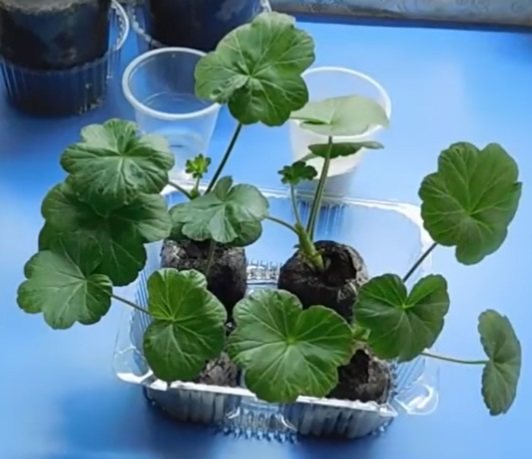

Seed-derived sprouts.
How to properly plant seedlings with tablets
Well, the long days of waiting are over. The sprouts rose and grew stronger. It's time to plant them in a greenhouse or open ground. How to determine this moment? Very easy. Lift one of the peat tablets. Roots make their way through the net, and the sprout itself has 3-4 true leaves? This means that the next stage has come.
You will need:
- seedling
- scapula
- stationery knife (optional)
- 2 hands
- water
Procedure. With a spatula, dig a hole of such a size that you can freely install the peat tablet. Pour in a little water. Then take the seedlings in one hand, carefully cut the mesh with the other with a clerical knife. Be careful that the tablet does not fall asleep. Next, put all this stuff in the hole, sprinkle it with earth. Try not to bury the plant, other than tomatoes. They can be planted under the very cotyledonous leaves.
Now you need to press the soil around a little. It remains only to lightly water the new settler and mulch the earth with humus or whatever is used to it. As you can see, everything is doable even for a beginner in agriculture.
By the way, about the mesh cut. This is not at all necessary, because it does not interfere with the growth of the root system absolutely. Moisture and fertilizers also flow completely unhindered to the plant. But some summer residents strongly recommend tearing the net. It is not clear what they are guided by. Therefore, the choice is yours.
How to prepare tablets for use
To sow seeds, the tablets must be prepared for use.
For this you will need:
- pallet or mini-greenhouse made of plastic with a transparent lid;
- a watering can for flowers or a container for spraying flowers with a spray bottle;
- water at room temperature or slightly warmer than room temperature.
First, we place the required number of tablets in a tray or greenhouse, pour water on the bottom of the selected container, so that the stream of water absorbs the tablets, but does not deform them. Wait a little until the added water is absorbed into the peat, then add more liquid.
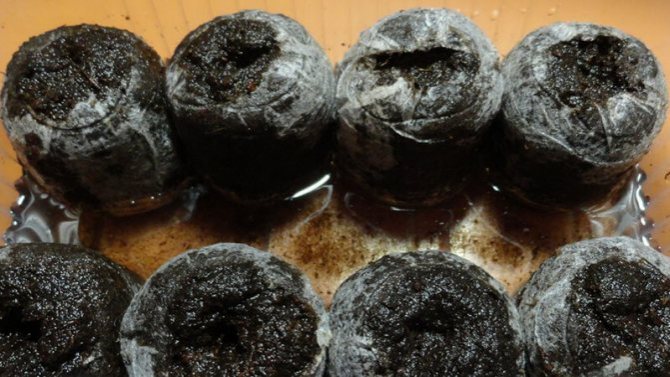

On average, it takes 20 to 30 minutes to soak peat tablets with water. As a result, the pill-washer turns into a wet cylinder about 8 cm high.
The excess water is drained, and later, when watering, make sure that the water does not stagnate in the pan, since, although the tablets contain antibacterial additives, excess moisture harms the seedlings.
Lovers growing seedlings through peat tablets know that there are several options for their placement:
Eustoma description
In nature, it has one color - purple, thanks to the breeders, a variety of colors have been developed. It is short from 30 cm and high 80 - 90 cm. Eustoma lisianthus starts branching from the middle of the stem, forming 20 - 30 buds.
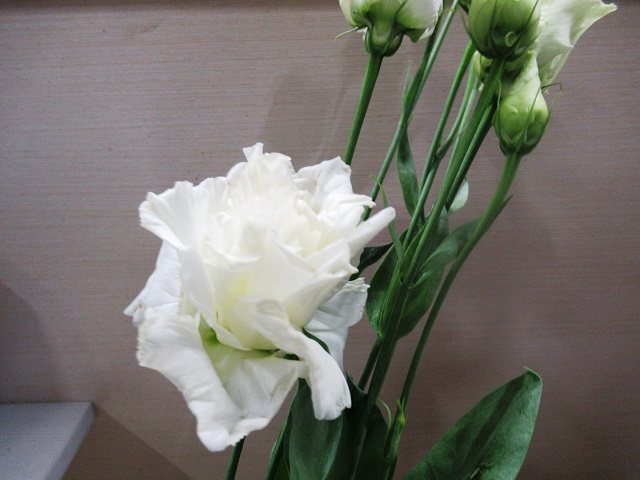

Eustoma white
With good care, there may be more buds, one flower looks like a full-fledged bouquet. The flowers can resemble not only roses, some varieties are similar to some daylilies, double mallow and poppies.
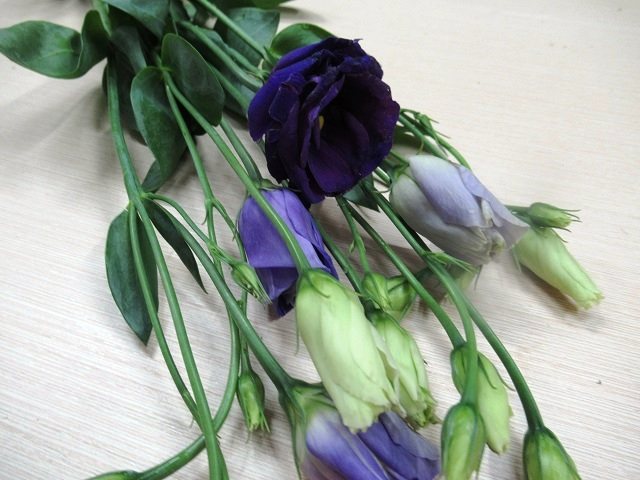

Eustoma is briefly the main thing.
- Flowering begins after sowing the seeds after 5 or 6 months.
- You can sow eustoma seeds until mid-February, starting in late November in the fall.
- Flowers do not tolerate transplanting well, so it is better to sow not in a bowl, but in a separate glass or container.
- Before mid-May, until the frost has passed, lisianthus is not planted in the greenhouse and in the ground.
- The Irish rose loves sunny locations and fertile soil.
- Moderate watering of the eustoma when the soil begins to dry out
- Eustoma has diseases and pests, like other flowers. Fundazole helps with lisianthus diseases such as powdery mildew, gray mold or fusarium wilting. Fitoverm for slugs, whiteflies, aphids.
What other pills are for seedlings
In addition to peat tablets for growing tomatoes, cucumbers and other crops, you can use pressed washers from other raw materials.
Uses of coconut pills ↑
If you plan to grow plants not in a common box, but separately, coconut seedling tablets are optimal for you. They consist of coconut - 70% peat, 30% shavings. For crops that need a lot of oxygen to grow, this material is best suited. Coconut flakes for seedlings serve as a nutritious component. The plus is that bacteria do not multiply in it and pests do not live in it.
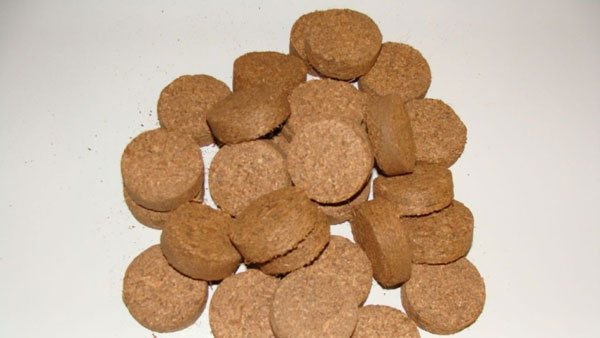

This is what coconut seed cylinders look like.
To prepare round dice for planting seeds, you need about 40 ml of warm water. You can pour the liquid directly onto the tablet. It will grow in size and taller, just like its peat counterpart. The difference is that after getting wet, the coconut flakes turn dark brown. It has good antibacterial and heat-conducting properties, as well as the ability to keep all the nutrients absorbed with water inside the fibers.
About coconut washers
The main difference between coconut washers and peat washers is in their composition. The ingredient is, in the first case, coconut flakes or fiber. They are produced in the form of washers or tiles, representing dry, dense round plates. They consist of coconut fiber - 60-70% and coconut flakes - 30-40%. These ingredients can be processed with special formulations - antibacterial, growth stimulants and pressed under high pressure, taking the shape of a circle.
Related material: How to grow pepper according to the lunar calendar
During production, a coconut washer for seedlings undergoes heat treatment, which destroys all dangerous microorganisms that can harm the plant. In water, these washers increase in size, absorbing moisture. So they become cylindrical. They are available in different diameters. Small washers are suitable for flower seedlings, larger ones for vegetables.
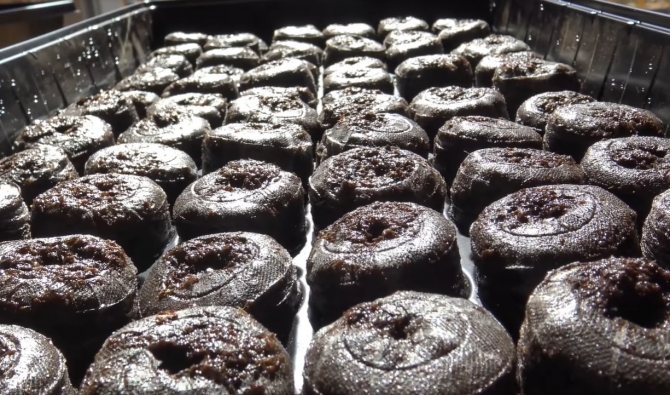

Water-swollen tablets.
Planting seeds in peat tablets
Peat tablet - a means for individual cultivation of plants, so the advice to plant two or three seeds in each, and then thin out, removing the weaker ones, makes no sense, since the sprouts in peat tablets appear almost simultaneously and are equally strong.
In addition, it is simply a pity to thin out the sprouts of expensive or rare seeds. Therefore, we plant one seed in the deepening of each peat tablet.
If the seeds are small, it is convenient to use a toothpick when planting.
After sprinkling the seeds on white paper or a saucer, we pick up the seed with the tip of a moistened toothpick and put it into the recess of the tablet, after which you can cover the recess by "fluffing up" the peat on top of the tablet with the same toothpick. Seeds that germinate in the light do not need to be sprinkled.
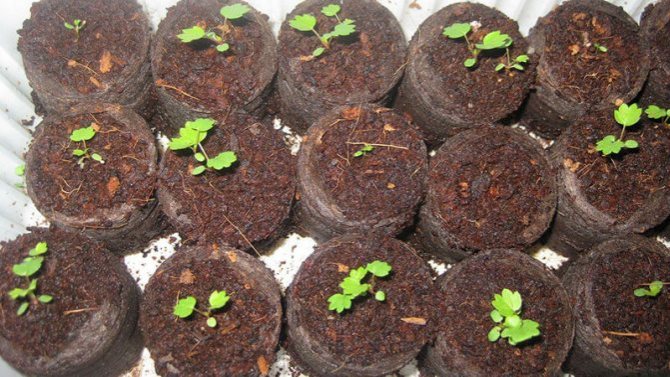

Larger seeds can be planted without using a toothpick by inserting them into the recess of the tablets with your fingers.
After planting the seeds, you do not need to water them, since the peat tablets are already soaked in water. The surface of the landing container with tablets is covered with glass, film or a plastic lid and placed in a bright place.
In the future, you should carefully watch that the tablets do not dry out, but periodically open containers with seedlings for airing.
How to use peat tablets
Before you start sowing seeds in peat-distilled tablets, take a good look at them. On one side, they have a small indentation for a seed. Take plastic cassettes or a pallet. Place the tablets in them so that the hole is on top. Thereafter:
- slightly warm up the previously settled water
- well spill tray of pills
- after 15 minutes, drain off excess water
- put 1 - 3 seeds on each tablet, if the culture is rare, then it is advisable not to put more than one
- if you need to plant seeds in the ground, then sprinkle them with fine sand, soil, humus
- to preserve moisture, cover with foil, glass
- Air the crops 1 - 2 times a day
- spray tablets and young shoots in a timely manner
An important point is that the tablets should have time to dry out a little, but not dry out completely, before the shoots appear, spraying is carried out carefully, without eroding the tablets from above. As soon as the seedlings reach the size at which they can be transplanted, then well loosen the soil in the garden bed, make holes, place tablets with seedlings in them, cover with earth and water the transplanted plant well.
Video about peat distillation tablets:
Coconut or peat washers which is better
This question is asked by many gardeners and summer residents, but there is no single opinion. You can use peat tablets for planting seeds, or you can use coconut tablets. Peat is better suited for the development of various crops in the early stages - after the seeding of seeds until the appearance of spikes. Peat soil allows air and water to pass better to the roots. Peat is a decayed plant that grew in swamps and swamps. It contains a large amount of nutrients that are essential for the growth and development of the sprouts.
Coconut cylinders have a fibrous structure, thanks to which they have good breathability. These tablets are better suited for shrubs, growing trees from seeds. The air permeability of peat is worse than that of coconut peel. When overflowing, sprouts in peat bogs have a greater risk of rotting. Agronomists say that seedlings need oxygen to grow, which is better permeated through coconut tablets.
Growing seedlings in tablets
Growing seedlings in peat tablets has some peculiarities in contrast to growing in the usual way.
First of all, the tablets are suitable for planting seedlings of those crops that are difficult to grow in boxes, capricious to the neighborhood or expensive seeds.
When planting, it is important to remember the rule: to plant seeds to a depth not exceeding twice the size of the seed itself. After planting, the container with tablets is placed in a warm place, but not near the radiator.
Until the shoots hatch, you can open the container for half an hour or an hour a day, for airing, monitor the level of moisture, avoiding getting wet.
Water is added by pouring it into the bottom of the container with tablets.In this case, the required volume of water is absorbed into the peat, and the excess is drained (for this, holes are made in the container with tablets in the bottom and placed in a tray).
After the emergence of seedlings, it is necessary to arrange ventilation more often, and care is carried out according to the requirements of a particular culture. If the technique of growing seedlings requires picking, you can transplant the seedlings into the ground without removing them from the tablet.
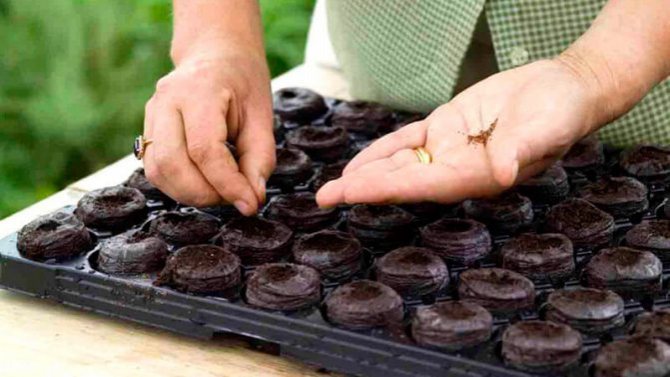

At the same time, some gardeners remove the mesh from the tablet so that it does not interfere with the roots from growing into the ground, but practice shows that even without this, the roots make their way through the mesh cells and develop quite successfully.
It is worth adding fertilizers and growth stimulants when growing seedlings in tablets only after two to three weeks after germination. Until then, the plants will have enough of those substances that are added to the tablets during their production. For top dressing, they are dissolved in water for irrigation. You can spray the seedlings with a spray bottle from above, taking care not to damage the plants.
After the seedlings have grown, peat tablets can be planted in pots with soil, and, if necessary, hardened by taking them out into fresh air (for example, on a balcony).
Otherwise, growing seedlings of vegetable and flower crops is similar to the traditional method (in boxes, pots).
Choosing a tablet for growing petunia
Anyone who has already come across this ornamental plant knows how small the seeds are in petunias. Look at them just right through a magnifying glass. It is better to buy such seeds pelleted, that is, in a thin shell of nutrients - this greatly facilitates planting. Since flowers are transplanted into the soil in the spring, seeds must be germinated already at the end of February. That is why the soil for plants should be moderately warm, loose, and also with a large number of useful elements. These are peat tablets. Their sizes, based on the size of the planting material, can be within 4 centimeters.
It is very important to inspect all cylinders before purchasing: they must have a dense structure of small particles. You should not take those tablets that are compressed from large fractions of peat. They are not saturated with air, absorb poorly, and give away moisture even worse. As for the absence or presence of a mesh, the second option is preferable. Of course, the roots of petunia are very delicate and will develop better in soil where there are no obstacles, but, as already mentioned, a wet tablet without a shell quickly falls apart. Therefore, we grow seedling bushes in peat cylinders with a shell, which, after the roots appear between the mesh cells, we carefully cut off (when transferring plants to the soil).
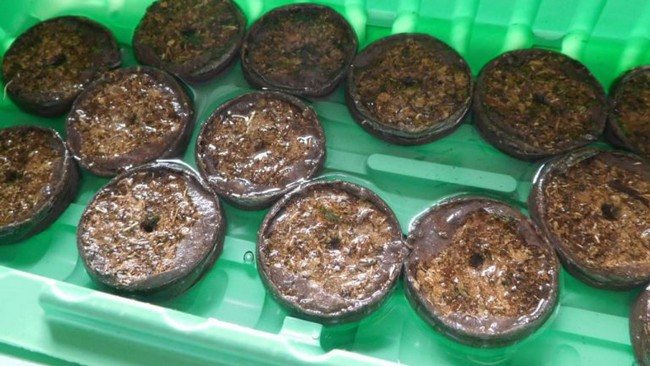

What crops are they intended for
It is generally accepted that peat tablets are intended for thermophilic crops, which often face difficulties in rooting. In fact, all crops can be germinated in this way. The advantages of peat tablets allow you to plant seeds of flowers, vegetables and other plants that should take place in the garden or dacha.
Some growers remove the outer shell before planting. This is not necessary, the roots of the plant can easily pierce it and penetrate into the soil.

